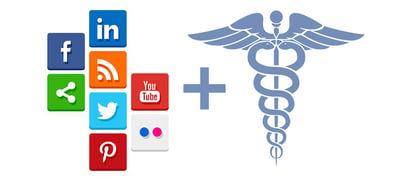Patient Satisfaction & Experience: High Touch & High Tech
See how Patient Experience & Patient Satisfaction is a "High Touch, High Tech" approach
Hospitals today are using social media to stay connected with their patients; it has become a vital tool for patient communication and care.

Everyone has been a patient. Everyone has communicated with some sort of medical professional. Truth is, healthcare impacts all of our lives and as more people turn to the Internet to find answers, physicians and hospitals are using social media to stay connected with their patients.
Social media sites allow hospitals to engage with patients, employees and other facilities by sharing relevant information, answering questions and prompting conversation. Facebook, Twitter, LinkedIn and Pinterest are on the rise, and we can expect significant growth in healthcare communication in the coming years on these platforms.

This infographic from Physician Designs highlights why social media makes sense for health professionals and hospitals.
Adding to this graphic, the fact that, 41% of nearly 23,000 respondents said that they use social media to research healthcare decisions, with nearly all those respondents—94%— saying that Facebook was their primary source. (Pew, 2012)
With these numbers in mind, hospitals cannot afford to ignore social media.
It is understandable why the health care industry has been slow to accept social media. Patient privacy is paramount in the industry and social media seems to be just the opposite.
Benefits:
• Reach new patients
• Answer questions from current patients
• Educate and inform
Concerns:
• Patient privacy
• Hospital liability
• Health Insurance Portability and Accountability Act (HIPAA)
Clear social media guidelines help prevent any issues from arising--check out this helpful article by Mashable).
These guidelines should state what your organization wants to accomplish by using social media and whom you want to reach. These guidelines should also clarify which staff members can contribute to the accounts. Planning and preparing in the beginning will minimize any risk involved.
While the demographic makeup of these sites may be shifting, the amount of people using social media sites is growing at an astounding rate. Included in each section is a list of hospitals and professionals to follow for inspiration and guidance while building your hospital’s social media sites.
Facebook’s features allow you to bring current and potential customers into your hospital in a virtual manner.
Posting pictures of staff members volunteering for a charitable organization or videos of staff members explaining why they love their job produce memorable content for patients, all while boosting staff morale.
These glimpses into hospital life provide insight to current and potential patients.
Top three healthcare pages to follow on Facebook:
• Regions Hospital
• University of MD Medical Center
• Wellmont Health System
Twitter can be used as a platform to answer patient questions quickly and efficiently.
With that in mind, it seems that physicians are turning to Twitter to do just that.
This movement makes perfect sense as the rest of society is transitioning to being constantly connected to the Internet.
Several physicians are now providing general well-being tips and links to health-related articles on Twitter.
Many physicians embracing Twitter give advice to worried patients and guide them to reliable material.
Hospitals who embrace Twitter as part of their social media plan grant instant access to their followers and make them feel connected and informed. This can lead to a higher level of respect and understanding of what the hospital contributes to the community.
Top three healthcare accounts to follow on Twitter:
• Ed Bennett
• Mike Sevilla
• Hive Strategies
The connections LinkedIn creates between current and past employees, other hospitals and future patients are phenomenal.
Posting recent updates about activities occurring within the hospital can create these connections.
Updates including graphics or videos tend to be more engaging and easier for viewers to follow.
Posts on LinkedIn tend to to start positive conversations about health-related topics.
On LinkedIn, a services page is available where hospitals can list what types of services they provide.
Each of the examples below built excellent service pages that followed a consistent design and included concise, memorable text.
Top three healthcare profiles to follow on LinkedIn:
• Apollo Hospitals
• Children’s Hospital of Wisconsin
• The Mount Sinai Hospital (our client!)
Pinterest provides a stockpile of resources. Hospitals can utilize Pinterest as a tool to bring current and potential clients into their network in a fun, social and easy manner.
Pinterest boards for patients can be anything from gluten-free recipes, to spine health tips, to parenting tips.
This wealth of topics and interests is what makes Pinterest a dynamic resource for hospitals.
Top hospitals to follow on Pinterest:
• BJC Healthcare
• Nationwide Children’s Hospital
• Baylor Health Care System
With the accessibility of mobile media today, most people use their smartphones, tablets and laptops daily.
This, plus the fact that these social media sites are gaining additional members daily, makes it easier for hospitals to connect with patients through social media. Facebook, Twitter, LinkedIn and Pinterest provide hospitals the opportunity to increase their social media presence and create a positive impact in their community.
How do you feel about hospitals and physicians using social media sites? Tell us what you think in the comment box below!
See how Patient Experience & Patient Satisfaction is a "High Touch, High Tech" approach
We delve into the heart of the patient experience and highlight the ten things that matter most to your patients.
Patient Satisfaction & Experience Approaches to Avoid
Be the first to know about new B2B SaaS Marketing insights to build or refine your marketing function with the tools and knowledge of today’s industry.